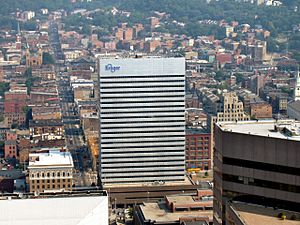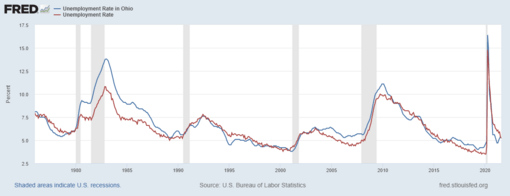Economy of Ohio facts for kids
The economy of Ohio is one of the largest in the United States. In 2017, Ohio's economy was so big that if it were a country, it would be the 21st largest in the world! This means it was bigger than countries like Argentina and close to Saudi Arabia. Ohio's total economic output, called its Gross Domestic Product (GDP), was about $656.19 billion in late 2017. This shows how much value the state creates in goods and services.
Ohio is often known as the "Nation's Industrial Capital." This goes back to its history as a major manufacturing area. Today, Ohio is also strong in science and technology. For example, Columbus, Ohio was named one of the world's "Smart 21 Communities" in 2014 for its focus on technology and innovation. Ohio also has many great universities and schools. In 2011, Ohio was ranked fourth in the U.S. for creating new jobs.

Dr. Kathryn Dwyer Sullivan, a resident of Columbus, was the first American woman to walk in space.
|
|
| Statistics | |
|---|---|
| GDP | $656.19 billion (3rd quarter 2017) |
|
Population below poverty line
|
15.4% |
| 0.4594 | |
|
Labor force
|
5,883,960 |
| Unemployment | 4.3% |
| Public finances | |
| Revenues | $27.3 billion |
| Expenses | $31 billion |
Contents
Manufacturing in Ohio
Ohio is a huge manufacturing state, ranking third in the U.S. after California and Texas. In 2017, Ohio's factories made nearly $108 billion in products. There are more than 12,000 manufacturing businesses in Ohio. About 12.6% of Ohio's workers have jobs in manufacturing.
Ohio is also the biggest maker of plastics and rubber products in the country. Major manufacturing companies like AK Steel, Timken, and Honda have a big presence here. Many foreign companies, especially from Japan, the United Kingdom, and Germany, also have factories in Ohio.
Key Industries and Innovation
Ohio is a center for science and industry. You can find science museums like COSI in Columbus, the Great Lakes Science Center in Cleveland, and the Imagination Station in Toledo.
The state has many strong industries that have been around for a long time. These include:
- Banking and Insurance: This industry makes up about 8% of Ohio's total economic output.
- Motor Vehicle Manufacturing: Ohio is a major car-making state. For example, almost all Honda Accord cars are made in Marysville, Ohio.
- Steel Production: Ohio produces a lot of the nation's raw steel, about 14-17% of it.
- Research and Development: Ohio is a hub for new ideas and inventions.
New and growing industries in Ohio include:
- Bioscience: This involves studying living things to create new products, like medicines. Ohio has the largest bioscience sector in the Midwest.
- Green Industries: These focus on environmentally friendly products and services. Ohio was ranked fourth in the country for green economic growth.
- Information Technology: This includes computer and tech-related jobs.
- Food Processing: Ohio's farms grow a lot of food, which then gets processed into products we buy. Ohio is the third largest producer of tomatoes in the U.S., and the world's largest ketchup factory is in Fremont, Ohio.
Ohio is also known as the "Fuel Cell Corridor" for its work on new energy sources. Different cities in Ohio specialize in different areas:
- Toledo is a national solar energy center.
- Cleveland is a hub for regenerative medicine research (growing new tissues and organs).
- Dayton is important for aerospace and defense.
- Columbus focuses on technology research and development.
- Cincinnati is a major business and trade center.
Major Employers and Companies

The biggest private employer in Ohio is Walmart, with about 50,500 employees in 2017. The largest Ohio-based company that employs the most people is the Cleveland Clinic, which has about 49,050 employees and is headquartered in Cleveland. The single largest employer at one location in Ohio is Wright Patterson Air Force Base in Dayton.
Ohio is home to many large companies. In 2010, 23 companies from Ohio were on the Fortune 500 list, which ranks the largest companies in the U.S. by revenue. Some of these famous companies include:
- Cardinal Health
- Procter & Gamble
- Kroger
- Macy's
- Nationwide Insurance
- Goodyear Tire and Rubber
- Progressive Insurance
- American Electric Power
- Eaton Corporation
- Owens Corning
Personal Income in Ohio
In 2015, the total personal income for everyone in Ohio was estimated to be $505 billion. In 2008, the average yearly salary for Ohioans was about $39,820.
The highest paid jobs in Ohio are often in the medical field. For example, in 2008, anesthesiologists (doctors who give pain medicine for surgery) earned about $211,060 per year. Other high-paying medical jobs included surgeons, orthodontists, and physicians.
Other professionals with good incomes included airline pilots, computer scientists, and chief executives. Police officers, chefs, and construction workers also earn good wages.
The average income per person in Ohio was $35,511 in 2009. This number can change depending on the county. For example, in Cuyahoga County, Ohio, where the Cleveland Clinic is located, the average family income was $54,506.
Images for kids
-
Procter & Gamble headquarters in Cincinnati.
-
GE Aviation, headquartered in Evendale, is a major manufacturer of aircraft engines. In 2010, EPISCENTER, a new R&D center for the corporation to be located in Dayton, was announced by the Third Frontier program. Aircraft engine manufacturing accounts for nearly 75% of Ohio's aerospace and defense industry workforce.
-
Weapon systems are integrated onto the M1131 Fire Support Vehicle, or Stryker FSV, at the Joint Systems Manufacturing Center in Lima.
-
General Electric's Global Operations Center is headquartered in Downtown Cincinnati
-
Wade Lagoon in University Circle, home to the Case Medical Center and neighboring Cleveland Clinic, which is set to begin human clinical trials of their breast cancer vaccine in 2011. Netherlands-based Philips Healthcare is currently constructing a medical imaging research and development center in the neighborhood, referred to as the Cleveland Health-Tech Corridor.
-
Miami Valley Hospital is ranked one of the nation's top hospitals with ratings from US News and World Report, Forbes, and HealthGrades.
-
The British Petroleum Tower located in Cleveland.
-
Ohio insurance employees work in a broad array of sub-industries. Around 44.8% of insurance employees work in fire, marine, and casualty insurance; this helps make Ohio the 4th largest casualty insurance state, in the measure of employees, trailing behind only California, New York, and Illinois.
-
Cincinnati hosts several large financial institutions and insurance companies
-
The Honda Accord was the single model that was most produced in Ohio. Almost all Accords are assembled in Marysville. The Accord's Ohio production exceeded 200,000, one of only five models to do so in Ohio.
-
The rubber and plastics industry in Ohio is largely dominated by Goodyear Tire & Rubber, in terms of revenue, although there are more non-rubber producing Fortune 500 rubber and plastics companies in Ohio than Ohio Fortune 500 rubber and plastics companies that do produce rubber.
-
The Longaberger Company former headquarters in Newark.
-
The Liquid Crystal Institute, headquartered on the campus of Kent State University, made early contributions to the liquid crystal display.
-
Hyland Software, headquartered in Westlake, is the developer of the enterprise content management software OnBase.
-
Macy's moved its headquarters to Cincinnati after it merged with Federated Department Stores in 1994
-
The Rock and Roll Hall of Fame is a well-visited tourist attraction in Cleveland. This is one of many tourist attractions that help make up Ohio's diverse tourism industry.
-
Put-in-bay, located on the Bass Islands in Lake Erie, attracts international tourism.
-
Ohio tourism expenditures by category. About 34.4% of the expenditures were on food, making food the highest of all Ohio tourism expenditures.





















